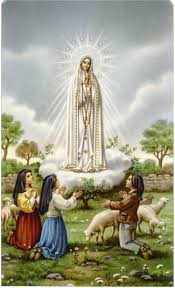HOMILY EASTER SEASON WEEK 07 01 – Year II
Firing Up Our Baptism:
Optional Memorial of Our Lady of Fatima
(Acts 19:1-8; Ps 68; Jn 16:29-33)
****************************************************
St. Thomas Aquinas once said, “God is sheer joy, and sheer joy demands company.” That saying is appropriate for us today.
The readings, and this mission, invite us to put the fire back into our baptism and joyfully build up the reign of God.
Preaching about the reign of God was central not just for Jesus, but also for St. Paul as we see in the first reading (“He entered the synagogue and for three months spoke out boldly and argued persuasively about the kingdom of God.”) The key to that kingdom is living out our baptism in the name of the Lord Jesus.
It is John the Baptist himself who said that there was a difference between his baptism of water, and the baptism of Jesus by fire. We need to continually move from the baptism of water to the baptism of fire.
Water cleans, but fire transforms. Fire changes, but water doesn’t. John can name sin, but he can’t forgive sin. He can tell us what is wrong but can’t cure it. All John does is self-help stuff, what we can do on our own – it is valuable but not transformative. John lays out the path towards the baptism of fire that is transformative, spiritual alchemy. We need John the Baptist to point us to our need for purity of heart; we need the Spirit of Jesus to purify our hearts. John can guide and direct but can’t take away the sin. John the Baptist’s baptism is naming sin, cleansing, making a path. Jesus’ baptism is transforming, taking away sin. We should never confuse John the Baptist (water) with Jesus (fire).
The fire that is in Jesus comes from his relationship with the Father. “I am leaving the world and going to the Father” he states in the Gospel. That is what the gospel is all about. Jesus lives in communion with the Father, and so must we. St. John, the beloved disciple, is the person with access to Jesus. Peter talks through John at the Last Supper, through the beloved part.
There is a support group for priests, started by priest who couldn’t stop turning towards the old habits he was struggling with. He realized that he needed grace and community to change, to heal and so invited other priests to join him on a healing journey.
The Quakers are known for what they call “sitting” – they gather and sit in silence, waiting for God to come and do for them, what they can’t do for themselves. The Oblates have a tradition of oraison, sitting in silent prayer each day. This contemplation is how we build community at a spiritual level, much more powerful than a psychological process. This is how St. Eugene, found of the Oblates, communed with his Oblates around the world, during his oraison before the Blessed Sacrament. He is an example for us. The book about him by Al Hubenig OMI is entitled Living in the Spirit’s Fire – a very fitting title as this man truly lived in the fire of the Holy Spirit.
Ron Rolheiser OMI gives an example of a seminarian who looked like Mother Theresa. He was very ascetic, studied, prayed, and was committed to social justice. He was a nice guy, all the actions were there, but he sucked the oxygen out of a room and ended up clinically depressed – he was being worn down by the water. Mother Theresa by contrast was transformed by fire, bringing energy into a room.
In a similar fashion, Richard Rohr OFM would say that a young person who tries to be a Mother Theresa is usually on an ego trip or in depression with rare exceptions. Are they worrying the kingdom into birth, or themselves to death by neurosis, he asks? Water won’t turn us into saints! The fire of the Holy Spirit and union with the Father and Jesus will.
 Today the church invites us to celebrate Mary as our Lady of Fatima. This title was given to the Blessed Virgin Mary after she appeared to three shepherd children in Fatima, Portugal, between May 13 and October 13, 1917, within the context of war and anti-Catholic persecution. The three messages or ‘secrets’ of Fatima stress the importance of repentance, conversion of heart, and dedication to Our Lady, especially through daily prayer of the Rosary.
Today the church invites us to celebrate Mary as our Lady of Fatima. This title was given to the Blessed Virgin Mary after she appeared to three shepherd children in Fatima, Portugal, between May 13 and October 13, 1917, within the context of war and anti-Catholic persecution. The three messages or ‘secrets’ of Fatima stress the importance of repentance, conversion of heart, and dedication to Our Lady, especially through daily prayer of the Rosary.
Mary is a wonderful model of contemplative prayer, abiding in God’s love, as described by Luke who mentions Mary “pondered these things in her heart” (Luke 2:19). She is also a model of one who balanced action and contemplation in her life, exemplified by her caring for her cousin Elizabeth in her pregnancy. We would do well to follow her example.
So, as we celebrate the Eucharist today during this last week of the Easter season, let us pray for the fire of the Spirit to help us come closer to the Father and to Jesus; to build community with one another, and to build up the reign of God here on earth.



